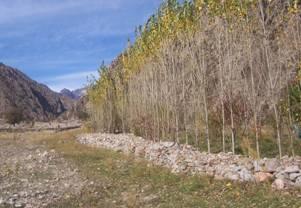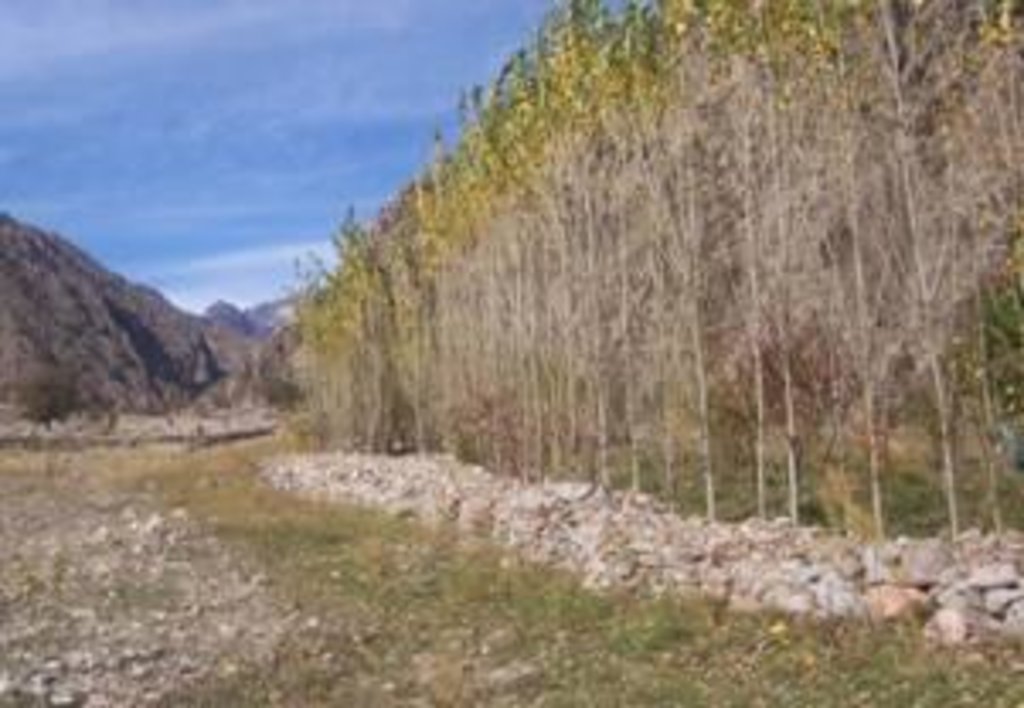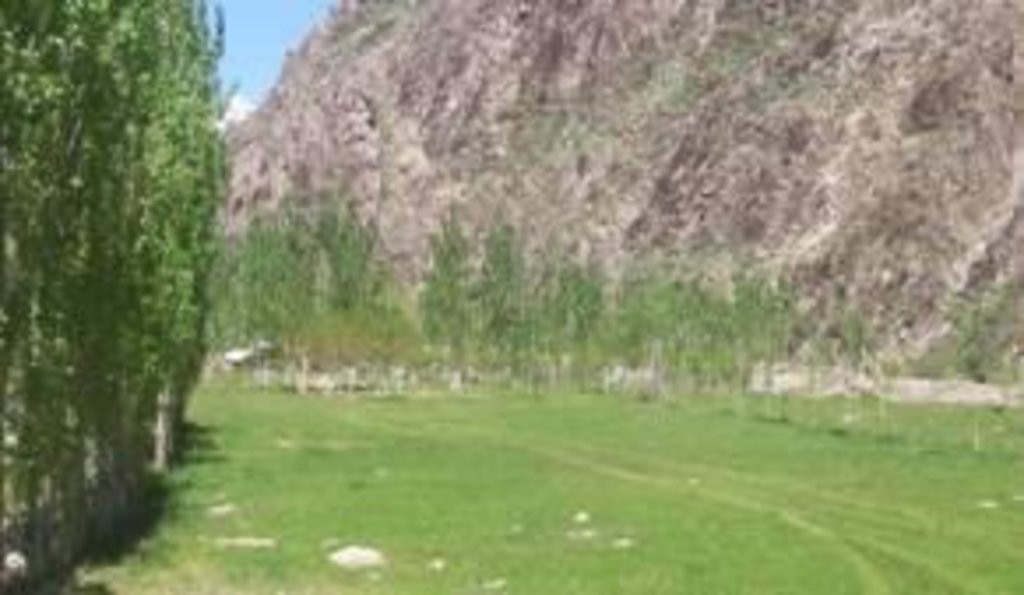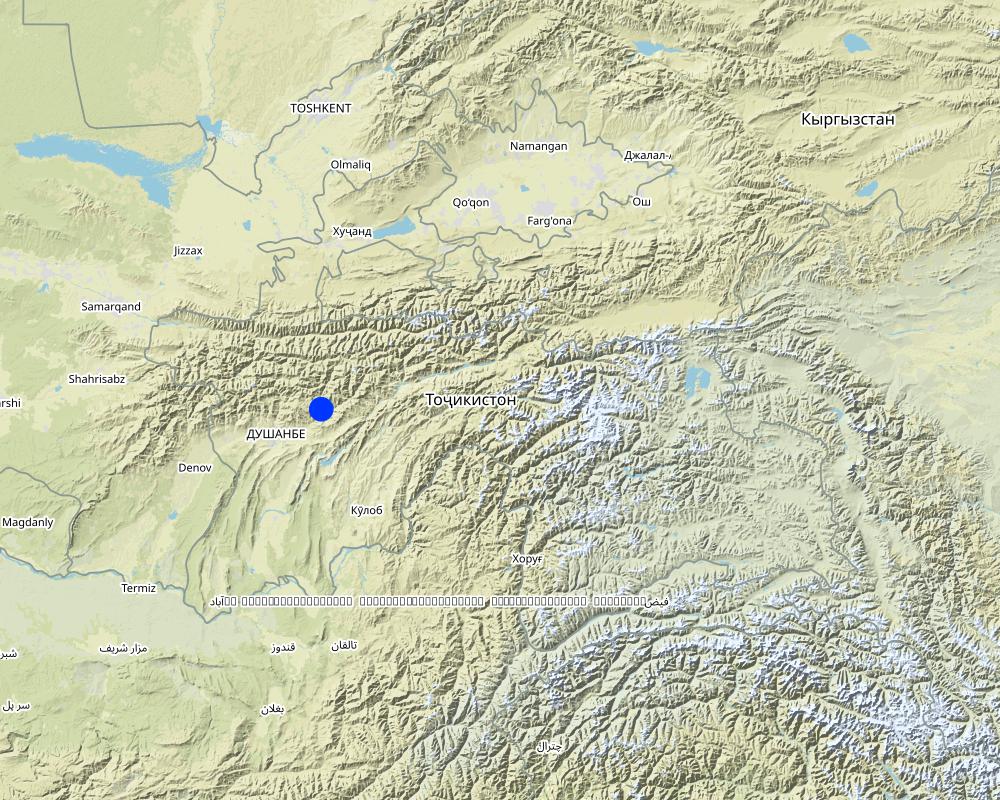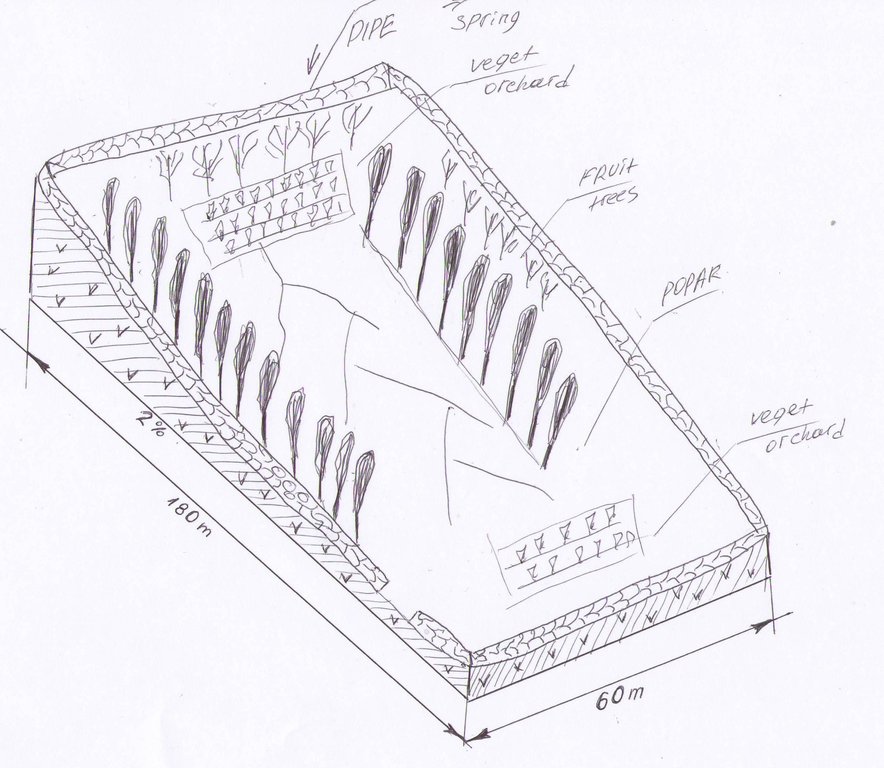Integrated stone wall and poplar tree perimeter fencing [ប្រទេសតាហ្ស៊ីគីស្ថាន]
- ការបង្កើត៖
- បច្ចុប្បន្នភាព
- អ្នកចងក្រង៖ Habib Kamolidinov
- អ្នកកែសម្រួល៖ –
- អ្នកត្រួតពិនិត្យច្រើនទៀត៖ Alexandra Gavilano, David Streiff, Joana Eichenberger
technologies_1107 - ប្រទេសតាហ្ស៊ីគីស្ថាន
- សង្ខេបជា PDF
- សេចក្តីសង្ខេបពេញលេញជាទម្រង់ PDF សម្រាប់បោះពុម្ព
- សេចក្តីសង្ខេបពេញលេញទម្រង់អ៊ីនធឺនេត
- សេចក្តីសង្ខេបពេញលេញ (មិនមានទម្រង់ជាក់លាក់)
- Integrated stone wall and poplar tree perimeter fencing: 21 ខែ មិនា ឆ្នាំ 2017 (inactive)
- Integrated stone wall and poplar tree perimeter fencing: 23 ខែ កក្កដា ឆ្នាំ 2017 (inactive)
- Integrated stone wall and poplar tree perimeter fencing: 14 ខែ សីហា ឆ្នាំ 2019 (inactive)
- Integrated stone wall and poplar tree perimeter fencing: 2 ខែ វិច្ឆិកា ឆ្នាំ 2021 (public)
ពិនិត្យមើលគ្រប់ផ្នែក
ពង្រីកមើលទាំងអស់ បង្រួមទាំងអស់1. ព័ត៌មានទូទៅ
1.2 ព័ត៌មានលម្អិតពីបុគ្គលសំខាន់ៗ និងស្ថាប័នដែលចូលរួមក្នុងការវាយតម្លៃ និងចងក្រងឯកសារនៃបច្ចេកទេស
អ្នកជំនាញឯកទេស SLM:
ឈ្មោះគម្រោងដែលបានចងក្រងឯកសារ/ វាយតម្លៃលើបច្ចេកទេស (បើទាក់ទង)
Pilot Program for Climate Resilience, Tajikistan (WB / PPCR)ឈ្មោះអង្គភាពមួយ (ច្រើន) ដែលបានចងក្រងឯកសារ/ វាយតម្លៃបច្ចេកទេស (បើទាក់ទង)
GITEC/ADB/DMC Rural Development Project Land Management Institute - ប្រទេសតាហ្ស៊ីគីស្ថាន1.3 លក្ខខណ្ឌទាក់ទងទៅនឹងការប្រើប្រាស់ទិន្នន័យដែលបានចងក្រងតាមរយៈ វ៉ូខេត
អ្នកចងក្រង និង(បុគ្គលសំខាន់ៗ)យល់ព្រមទទួលយកនូវលក្ខខណ្ឌនានាទាក់ទងទៅនឹងការប្រើប្រាស់ទិន្នន័យដែលបានចងក្រងតាមរយៈវ៉ូខេត:
បាទ/ចា៎
2. ការពណ៌នាពីបច្ចេកទេស SLM
2.1 ការពណ៌នាដោយសង្ខេបពីបច្ចេកទេស
និយមន័យបច្ចេកទេស:
Stones cleared from land within a narrow valley floor where flat land is at a premium, was used to construct a perimeter stone wall which was subsequently supplemented with a row of poplar tree to protect an agro-forestry area with small scale supplementary irrigation.
2.2 ការពណ៌នាលម្អិតពីបច្ចេកទេស
ការពណ៌នា:
The area in question is a very narrow, flat valley floor, 95% of which was covered in stones and boulders, and devoid of vegetation, both grass and trees/shrubs. The stones in the area were cleared and used to build a protecting, perimeter wall (approx. 1.5 m high). This was then supplemented by an inner row of fast growing poplar trees. The stone clearing has resulted in deeper soil within the protected area that has led to far greater vegetation coverage, such as grass (that can be cut and used as fodder), forest and orchard trees and vegetable gardens. Irrigation was provided to the area by a small diameter poly pipe from a permanent spring. The area is now being extended to almost double the size of the initial walled agro-forest area.
Purpose of the Technology: The farmer’s primary aim, in initiating and continuing this SLM approach, was to “leave a legacy of improved land” for future generations, recognising how little flat and potentially productive land there is in this high, narrow valley location. Clearing the land of stones and building a walled enclosure that was irrigated greatly assured the quantity and quality of fodder for his animals, as they remain fenced in beside his village home almost all year. Fruit and vegetable production was also greatly improved.
Establishment / maintenance activities and inputs: The family commenced stone clearing and wall construction in 2005. The next task was tree planting; poplar trees were planted around the wall's perimeter. The irrigation source was tapped into using a poly pipe. The vegetable gardens are seasonal and their plants change with the seasons and the family’s needs. Stone removal continues even now, to improve the soil in the walled area. The farmer hopes to extend the walled area in the future.
Natural / human environment: Before the family began clearing stones and building the wall, this land had almost zero productivity. This area has a shortage of cultivated land and with increases in popluation and continued food insecurity, cultivated land is at a premium.
2.3 រូបភាពនៃបច្ចេកទេស
2.5 ប្រទេស/តំបន់/ទីតាំងកន្លែង ដែលបច្ចេកទេសត្រូវបានអនុវត្ត និងបានគ្រប់ដណ្តប់ដោយការវាយតម្លៃនេះ
ប្រទេស:
ប្រទេសតាហ្ស៊ីគីស្ថាន
តំបន់/រដ្ឋ/ខេត្ត:
Central District of Tajikistan
បញ្ជាក់បន្ថែមពីលក្ខណៈនៃទីតាំង:
Kushon village, Romit Jamoat, Vahdat
បញ្ជាក់ពីការសាយភាយនៃបច្ចេកទេស:
- ត្រូវបានផ្សព្វផ្សាយត្រឹមតំបន់មួយ
ប្រសិនបើមិនច្បាស់ពីទំហំផ្ទៃដី សូមធ្វើការប៉ាន់ប្រម៉ាណ:
- < 0.1 គម2 (10 ហិកតា)
មតិយោបល់:
A small area was all that the family could manage as there was an initial large workload, clearing stones and fence building, etc
Map
×2.6 កាលបរិច្ឆេទនៃការអនុវត្ត
ប្រសិនបើមិនច្បាស់ឆ្នាំ សូមបញ្ជាក់កាលបរិច្ឆេទដែលប្រហាក់ប្រហែល:
- តិចជាង 10ឆ្នាំមុន (ថ្មី)
2.7 ការណែនាំពីបច្ចេកទេស
សូមបញ្ជាក់តើបច្ចេកទេសត្រូវបានណែនាំឱ្យអនុវត្តដោយរបៀបណា:
- តាមរយៈការបង្កើតថ្មីរបស់អ្នកប្រើប្រាស់ដី
មតិយោបល់ (ប្រភេទនៃគម្រោង ។ល។):
The initiative began in 2005 and has been ongoing ever since, it continues to improve, at least up to 2010 when reviewed.
3. ចំណាត់ថ្នាក់នៃបច្ចេកទេស SLM
3.1 គោលបំណងចម្បង (១ ឬច្រើន) នៃបច្ចេកទេសនេះ
- increase size of agrictultural land
3.2 ប្រភេទដីប្រើប្រាស់មួយប្រភេទ (ច្រើនប្រភេទ) ដែលបានអនុវត្តបច្ចេកទេស
ដីប្រើប្រាស់ចម្រុះនៅលើដីតែមួយ:
បាទ/ចា៎
បញ្ជាក់ពីប្រភេទដីច្រើនប្រភេទ (ដីដាំដំណាំ/ដីចិញ្ចឹមសត្វ/ដីព្រៃឈើ):
- កសិរុក្ខកម្ម

ដីដាំដំណាំ
- ដំណាំប្រចាំឆ្នាំ
- ដំណាំរយៈពេលវែង (មិនមែនឈើ)
- ប្រភេទដើមឈើធំៗ និងដើមឈើតូចៗ
ប្រភេទដើមឈើធំៗ និងដើមឈើតូចៗ - បញ្ជាក់ប្រភេទ:
- stone fruits (ផ្លែប៉េស, apricot, ផ្លែឆឺរី, plum ។ល។)
- ផ្លែប៉ោម (ប៉ោម សារី ។ល។)
ចំនួនសារដែលដាំដំណាំក្នុងមួយឆ្នាំ:
- 1
សូមបញ្ជាក់:
Longest growing period in days: 180Longest growing period from month to month: April to September

ដីសម្រាប់ចិញ្ចឹមសត្វ
ប្រភេទសត្វ:
- សត្វពាហនៈ - សត្វចិញ្ចឹមយកទឹកដោះ
- សត្វចៀម

ដីព្រៃ/ដីដាំដើមឈើ
ផលិតផល និងសេវាកម្ម:
- អុស
- ផ្លែឈើ និងគ្រាប់ធញ្ញជាតិ
- ផលិតផលព្រៃផ្សេងៗ
មតិយោបល់:
Major land use problems (compiler’s opinion): This area is strongly dependent on the extremely limited flat, valley bottom land for the production of pasture, 'cut and carry' fodder, orchards and vegetable production. 95% of this land is covered in stones that require removal before any productive capacity can be achieved. Even when cleared of stones the soil is still very shallow (< 20cm) and requires irrigation to ensure plants survive the hot summer months
Major land use problems (land users’ perception): Same – the above words were used by him in the on-farm interview
Cut-and-carry/ zero grazing: sheep/cattle
Plantation forestry: The Poplar trees they planted are pruned and thinned for firewood and construction materials
Other type of forest: orchard species: Apple, Apricot, Cherry
Forest products and services: timber, fuelwood, fruits and nuts
Future (final) land use (after implementation of SLM Technology): Grazing land: Gi: Intensive grazing/ fodder production
3.3 បន្ទាប់ពីអនុវត្តបច្ចេកទេស តើដីប្រើប្រាស់មានការប្រែប្រួលដែររឺទេ?
បន្ទាប់ពីអនុវត្តបច្ចេកទេស តើដីប្រើប្រាស់មានការប្រែប្រួលដែររឺទេ?
- បាទ/ច៎ា (សូមបំពេញសំណួរខាងក្រោមពីស្ថានភាពដីប្រើប្រាស់មុនពេលអនុវត្តបច្ចេកទេស)

ដីសម្រាប់ចិញ្ចឹមសត្វ

ផ្សេងៗ
សូមបញ្ជាក់:
wastelands, deserts, glaciers, swamps, recreation areas, etc
3.4 ការផ្គត់ផ្គង់ទឹក
ការផ្គត់ផ្គង់ទឹកនៅកន្លែងអនុវត្តបច្ចេកទេស:
- ទឹកភ្លៀង និងប្រព័ន្ធស្រោចស្រព
3.5 ក្រុម SLM ដែលបច្ចេកទេសស្ថិតនៅក្នុង
- កសិរុក្ខកម្ម
- ធ្វើឱ្យប្រសើរឡើងគម្របដី/ ដំណាំគម្របដី
3.6 វិធានការ SLM ដែលបញ្ចូលនូវបច្ចេកទេស

វិធានការក្សេត្រសាស្ត្រ
- A1: ដំណាំ/គម្របដី

វិធានការរុក្ខជាតិ
- V1: ឈើធំៗ និងដើមឈើតូចៗ
- V2: ស្មៅនិងរុក្ខជាតិៗដែលដុះមានអាយុមិនលើសពី 2ឆ្នាំ

វិធានការរចនាស័ម្ពន្ធ
- S6: ជញ្ជាំង, របាំង, របងឈើខ្ពស់ៗ

វិធានការគ្រប់គ្រង
- M1: ការផ្លាស់ប្តូរប្រភេទដីប្រើប្រាស់
- M2: ការផ្លាស់ប្តូរការគ្រប់គ្រង/ កម្រិតអាំងតង់ស៊ីតេ
- M3: ប្លង់យោងទៅតាមធម្មជាតិ និងបរិស្ថានធម្មជាតិ
- M4: ការផ្លាស់ប្តូរចម្បងៗក្នុងការកំណត់ ពេលអនុវត្តសកម្មភាព
- M5: គ្រប់គ្រង/ ការប្លាស់ប្តូរសមាសភាពពូជ
មតិយោបល់:
Main measures: agronomic measures, vegetative measures, structural measures, management measures
Type of agronomic measures: better crop cover, mixed cropping / intercropping, cover cropping, retaining more vegetation cover, furrows (drainage, irrigation)
Type of vegetative measures: aligned: -along boundary, in blocks
3.7 កំណត់ប្រភេទនៃការធ្លាក់ចុះគុណភាពដីសំខាន់ៗដែលបច្ចេកទេសនេះបានដោះស្រាយ

ការហូរច្រោះដីដោយសារទឹក
- Wt: ការបាត់ដីស្រទាប់លើដោយការហូរច្រោះ

ការធ្លាក់ចុះជីវសាស្ត្រនៃដី
- Bc: ការថយចុះនូវគម្របរុក្ខជាតិ
- Bh: ការបាត់បង់ទីជំរក
- Bq: ការថយចុះនូវជីវម៉ាស/ បរិមាណ
- Bl: ការបាត់បង់មីក្រូ និងម៉ាក្រូសរីរាង្គរបស់ដី
មតិយោបល់:
Main type of degradation addressed: Wt: loss of topsoil / surface erosion, Bc: reduction of vegetation cover, Bh: loss of habitats, Bq: quantity / biomass decline, Bl: loss of soil life
Secondary causes of degradation: land tenure (The lack of good quality available land puts pressure on the lower grade land.), poverty / wealth (People still need land to harvest to survive.)
3.8 ការពារ កាត់បន្ថយ ឬស្តារឡើងវិញនៃការធ្លាក់ចុះគុណភាពដី
បញ្ជាក់ពីគោលដៅរបស់បច្ចេកទេស ដែលផ្តោតទៅការធ្លាក់ចុះគុណភាពដី:
- ការជួសជុល/ ស្តារឡើងវិញនៃឱនភាពដីធ្ងន់ធ្ងរ
មតិយោបល់:
Secondary goals: prevention of land degradation, mitigation / reduction of land degradation
4. បច្ចេកទេសជាក់លាក់ សកម្មភាពអនុវត្ត ធាតុចូល និងថ្លៃដើម
4.1 គំនូសបច្ចេកទេសនៃបច្ចេកទេសនេះ
លក្ខណៈពិសេសនៃបច្ចេកទេស (ទាក់ទងនឺងគំនូរបច្ចេកទេស):
The drawing shows a 1.5m high stone wall, lined with poplar trees on a gentle slope. The site is located in the valley floor and has access to a naturally occuring spring. The enclosed land is now used mainly for fodder production, intercropped with fruit trees and vegetable patches.
Location: Khatlon province. Kushon village, Romit jamoat, Vahdat raion
Date: 21.04.2011
Technical knowledge required for land users: high (The farmer has a good understanding of farming techniques.)
Main technical functions: improvement of ground cover, improvement of topsoil structure (compaction), increase in organic matter, increase in nutrient availability (supply, recycling,…), increase of infiltration, increase / maintain water stored in soil, increase of biomass (quantity), promotion of vegetation species and varieties (quality, eg palatable fodder)
Secondary technical functions: control of dispersed runoff: impede / retard, reduction of slope angle, reduction of slope length, improvement of subsoil structure (hardpan), stabilisation of soil (eg by tree roots against land slides), increase of groundwater level / recharge of groundwater, reduction in wind speed, spatial arrangement and diversification of land use
Better crop cover
Material/ species: Perennial pasture (grass) for fodder
Quantity/ density: 100 %
Remarks: covers 1.3 ha
Mixed cropping / intercropping
Material/ species: Forest and orchard trees with fodder grasses and vegetable gardens
Quantity/ density: 100
Remarks: dramatically increased
Cover cropping
Material/ species: Perennial grass is the cover crop
Quantity/ density: 100
Remarks: dramatically increased
Retaining more vegetation cover
Material/ species: Land previously bare and stony
Quantity/ density: 100
Remarks: vegetation cover increased
Furrows (drainage, irrigation)
Material/ species: Irrigation via hand cut 20cm cube ditches and poly pipe from nearby spring
Agronomic measure: Stone removal and clearance
Aligned: -along boundary
Vegetative material: T : trees / shrubs
Number of plants per (ha): 1200
Spacing between rows / strips / blocks (m): 1 m
In blocks
Vegetative material: F : fruit trees / shrubs
Number of plants per (ha): 60% cover
Vertical interval between rows / strips / blocks (m): About 0.5 ha planted
Trees/ shrubs species: Poplar trees - planted
Fruit trees / shrubs species: Apple, cherry, apricot - planted
Grass species: Grass - natural
Other species: Vegetable garden - planted
Slope (which determines the spacing indicated above): 0.00%
Wall/ barrier
Vertical interval between structures (m): Wall around area
Height of bunds/banks/others (m): 1.5
Width of bunds/banks/others (m): 0.7
Length of bunds/banks/others (m): 500
Construction material (stone): Stone wall – from stones removed from within area
Lateral gradient along the structure: 3 degrees%
ឈ្មោះអ្នកនិពន្ធ:
Des Mcgarry, Land Management Institute, Giprozem 15, Dushanbe, Tajikistan
4.2 ព័ត៌មានទូទៅដែលពាក់ព័ន្ធនឹងការគណនាធាតុចូល និងថ្លៃដើម
ផ្សេងៗ/ រូបិយប័ណ្ណជាតិ (បញ្ជាក់):
somoni
បើពាក់ព័ន្ធសូមកំណត់អត្រាប្តូរប្រាក់ពីដុល្លាទៅរូបិយប័ណ្ណតំបន់ (ឧ. 1 ដុល្លារ = 79.9 រៀលនៃរូបិយប័ណ្ណប្រេស៊ីល) ៖ 1 ដុល្លារ =:
4,5
កំណត់ថ្លៃឈ្នួលជាមធ្យមនៃការជួលកម្លាំងពលកម្មក្នុងមួយថ្ងៃ:
4.50
4.3 សកម្មភាពបង្កើត
| សកម្មភាព | រយៈពេល (រដូវកាល) | |
|---|---|---|
| 1. | Stone clearing | On initial set up |
| 2. | Wall building | On initial set up |
| 3. | Tree planting | annually |
| 4. | Irrigation pipe | On initial set up |
| 5. | Vegetable garden | annually |
4.4 ថ្លៃដើម និងធាតុចូលដែលត្រូវការសម្រាប់ការបង្កើតបច្ចេកទេស
| បញ្ជាក់ពីធាតុចូល | ឯកតា | បរិមាណ | ថ្លៃដើមក្នុងមួយឯកតា | ថ្លៃធាតុចូលសរុប | % នៃថ្លៃដើមដែលចំណាយដោយអ្នកប្រើប្រាស់ដី | |
|---|---|---|---|---|---|---|
| កម្លាំងពលកម្ម | Stone clearing | Persons/day | 15,0 | 50,0 | 750,0 | 100,0 |
| កម្លាំងពលកម្ម | Wall building | Persons/day | 15,0 | 50,0 | 750,0 | 100,0 |
| កម្លាំងពលកម្ម | Tree planting | Persons/day | 10,0 | 25,0 | 250,0 | 100,0 |
| កម្លាំងពលកម្ម | Vegetable garden | Persons/day | 20,0 | 15,0 | 300,0 | 100,0 |
| សម្ភារៈ | Tools | Pieces | 6,0 | 16,66666666 | 100,0 | 100,0 |
| សម្ភារៈដាំដុះ | Trees | Pieces | 100,0 | 10,0 | 1000,0 | 100,0 |
| សម្ភារៈដាំដុះ | Plants for vegetable garden | - | 1,0 | 450,0 | 450,0 | 100,0 |
| សម្ភារៈសាងសង់ | Irrigation pipe | meter | 700,0 | 3,0 | 2100,0 | 100,0 |
| សម្ភារៈសាងសង់ | Wall | meter | 500,0 | 7,0 | 3500,0 | 100,0 |
| ថ្លៃដើមសរុបក្នុងការបង្កើតបច្ចេកទេស | 9200,0 | |||||
| ថ្លៃដើមសរុបក្នុងការបង្កើតបច្ចេកទេសគិតជាដុល្លារ | 2044,44 | |||||
មតិយោបល់:
Duration of establishment phase: 12 month(s)
4.5 សកម្មភាពថែទាំ
| សកម្មភាព | ពេលវេលា/ ភាពញឹកញាប់ | |
|---|---|---|
| 1. | Stone clearing | Annually |
| 2. | Vegetable garden | Annually |
| 3. | Tree planting | Annually |
| 4. | Animal husbandry | Annually |
| 5. | Fertilising and cultivating (garden vegetables) | Annually |
| 6. | Tree planting | Annually |
| 7. | Vegetable planting | Seasonally |
| 8. | random stone removal | Annual |
4.6 កំណត់ថ្លៃដើមសម្រាប់ការថែទាំ/ សកម្មភាពរបស់បច្ចេកទេស (ក្នុងរយៈពេលមួយឆ្នាំ)
| បញ្ជាក់ពីធាតុចូល | ឯកតា | បរិមាណ | ថ្លៃដើមក្នុងមួយឯកតា | ថ្លៃធាតុចូលសរុប | % នៃថ្លៃដើមដែលចំណាយដោយអ្នកប្រើប្រាស់ដី | |
|---|---|---|---|---|---|---|
| កម្លាំងពលកម្ម | Stone clearing | Persons/day | 10,0 | 25,0 | 250,0 | 100,0 |
| កម្លាំងពលកម្ម | Vegetable garden | Persons/day | 50,0 | 25,0 | 1250,0 | 100,0 |
| កម្លាំងពលកម្ម | Tree planting | Persons/day | 20,0 | 15,0 | 300,0 | 100,0 |
| កម្លាំងពលកម្ម | Animal husbandry | Persons/day | 40,0 | 15,0 | 600,0 | 100,0 |
| ផ្សេងៗ | Labour: Fertilising and cultivating | Persons/day | 20,0 | 15,0 | 300,0 | 100,0 |
| ផ្សេងៗ | Labour: Random stone removal | Persons/day | 10,0 | 15,0 | 150,0 | 100,0 |
| ថ្លៃដើមសរុបសម្រាប់ការថែទាំដំណាំតាមបច្ចេកទេស | 2850,0 | |||||
| ថ្លៃដើមសរុបសម្រាប់ការថែទាំដំណាំតាមបច្ចេកទេសគិតជាដុល្លារ | 633,33 | |||||
មតិយោបល់:
Machinery/ tools: All works done manually., all done manually, All work done manually.
Wall – length; all money spent in first 1 or 2 years
Trees – per unit tree; initial start up and annual costs, now ongoing.
Vegetable seeds – per packet, annually
4.7 កត្តាសំខាន់បំផុតដែលមានឥទ្ធិពលដល់ការចំណាយ
ពណ៌នាពីកត្តាប៉ះពាល់ចម្បងៗទៅលើថ្លៃដើម:
The human labour costs involving the family were nothing as they willingly gave of their time to clear the land and build the wall, plant trees and create vegetable gardens. The real labour cost were the few days when the farmer paid 3 men to help build the wall.
The cost of the wall cost was also nothing as all materials came from on site.
Trees – there was an initial start up cost and the farmer said he tries to plant at least 20 new trees each year to maintain and enhance productivity
Grasses (fodder) – are self regenerating and local. The farmer has never bought grass seed or used fertiliser on the grass
5. លក្ខណៈបរិស្ថានធម្មជាតិ និងមនុស្ស
5.1 អាកាសធាតុ
បរិមាណទឹកភ្លៀងប្រចាំឆ្នាំ
- < 250 មម
- 251-500 មម
- 501-750 មម
- 751-1,000 មម
- 1,001-1,500 មម
- 1,501-2,000 មម
- 2,001-3,000 មម
- 3,001-4,000 មម
- > 4,000 មម
លក្ខណៈពិសេស/ មតិយោបល់លើរដូវភ្លៀង:
Dominate in Spring (March-May) The period June to September is very hot and dry (almost no rain).
តំបន់កសិអាកាសធាតុ
- មានភ្លៀងតិចតួច
Thermal climate class: temperate
5.2 សណ្ឋានដី
ជម្រាលជាមធ្យម:
- រាបស្មើ (0-2%)
- ជម្រាលតិចតួច (3-5%)
- មធ្យម (6-10%)
- ជម្រាលខ្ពស់បន្តិច (11-15%)
- ទីទួល (16-30%)
- ទីទួលចោត (31-60%)
- ទីទួលចោតខ្លាំង (>60%)
ទម្រង់ដី:
- ខ្ពង់រាប
- កំពូលភ្នំ
- ជម្រាលភ្នំ
- ជម្រាលទួល
- ជម្រាលជើងភ្នំ
- បាតជ្រលងភ្នំ
តំបន់តាមរយៈកម្ពស់ :
- 0-100 ម
- 101-500 ម
- 501-1,000 ម
- 1,001-1,500 ម
- 1,501-2,000 ម
- 2,001-2,500 ម
- 2,501-3,000 ម
- 3,001-4,000 ម
- > 4,000 ម
មតិយោបល់ និងបញ្ចាក់បន្ថែមអំពីសណ្ឋានដី :
Altitudinal zone: The centre of the site is at 1,305 meters a.s.l
Landforms: The site is slightly sloped, north to south.
5.3 ដី
ជម្រៅដីជាមធ្យម:
- រាក់ខ្លាំង (0-20 សម)
- រាក់ (21-50 សម)
- មធ្យម (51-80 សម)
- ជ្រៅ (81-120 សម)
- ជ្រៅខ្លាំង (> 120 សម)
វាយនភាពដី (ស្រទាប់លើ):
- មធ្យម (ល្បាយ, ល្បាប់)
សារធាតុសរីរាង្គនៅស្រទាប់ដីខាងលើ:
- ខ្ពស់ (>3%)
បើអាចសូមភ្ជាប់ការពណ៌នាពីដីឱ្យបានច្បាស់ ឬព័ត៌មានដែលអាចទទួលបាន ឧ. ប្រភេទដី, pH ដី/ ជាតិអាស៊ីត, សមត្ថភាពផ្លាស់ប្តូរកាចុង, វត្តមាននីត្រូសែន, ភាពប្រៃ ។ល។:
Soil depth on average: Before intervention the soil was <1cm in depth. Now 20-30cm average depth.
Soil texture: Loess soil – silty loam
Soil fertility is high and with proper management/intervention these soils are very fertile. Before the intervention they were virtually infertile.
Topsoil organic matter is medium with intervention (<1% before).
Soil drainage / infiltration is medium
Soil water storage capacity is medium because loess soils are low in clay (high in silt) – so have moderate PAWC.
5.4 ទឹកដែលអាចទាញមកប្រើប្រាស់បាន និងគុណភាពទឹក
នីវ៉ូទឹកក្រោមដី:
5-50 ម
ទឹកលើដីដែលអាចទាញយកប្រើប្រាស់បាន:
ល្អ
គុណភាពទឹក (មិនបានធ្វើប្រត្តិកម្ម):
ទឹកពិសារដែលមានគុណភាពល្អ
មតិយោបល់ និងលក្ខណៈពិសេសផ្សេងៗទៀតលើគុណភាព និងបរិមាណទឹក :
Availability of surface water: Also medium
Water quality (untreated): The spring water is almost pure water
5.5 ជីវៈចម្រុះ
ភាពសម្បូរបែបនៃប្រភេទ:
- កម្រិតមធ្យម
5.6 លក្ខណៈនៃអ្នកប្រើប្រាស់ដីដែលអនុវត្តបច្ចេកទេស
ទីផ្សារនៃប្រព័ន្ធផលិតកម្ម:
- សម្រាប់ហូបក្នុងគ្រួសារ (ផ្គត់ផ្គង់ខ្លួនឯង)
ចំណូលក្រៅកសិកម្ម:
- 10-50% នៃចំណូល
កម្រិតជីវភាព:
- មិនល្អ
ឯកជន ឬក្រុម:
- ធ្វើខ្លួនឯង/ គ្រួសារ
កម្រិតប្រើប្រាស់គ្រឿងយន្ត:
- ប្រើកម្លាំងពលកម្ម
យេនឌ័រ:
- បុរស
សូមបញ្ជាក់ពីលក្ខណៈពាក់ព័ន្ធផ្សេងទៀតអំពីអ្នកប្រើប្រាស់ដី:
Land users applying the Technology are mainly common / average land users
Difference in the involvement of women and men: Not a large difference. The farmer’s wife shares the workload but tends to focus more on the garden, fruit production, household duties and bee keeping. The farmer conducts hay cutting and gathering, stone removal, fence upkeep and animal tending (feeding and slaughtering when required).
Population density: < 10 persons/km2
Annual population growth: 1% - 2%
100% of the land users are poor.
Off-farm income specification: The issue is that the older and the very young family members (ie the farmer and his wife are in their late 50s ) stay on the farm. The rest (18 to 50 yrs ) have paid employment in Dushanbe and Russia, and only visit the farm, occasionally. However, it is believed they part-finance (contribute) to the upkeep of the family farm.
Market orientation of production system: All of the farm produce stays on the farm for home consumption, but they do eat well and very healthy (fresh and organic) food. Their cattle are also well fed and healthy .
5.7 ទំហំផ្ទៃដីជាមធ្យមនៃដីប្រើប្រាស់ដោយអ្នកប្រើប្រាស់ដី ក្នុងការអនុវត្តបច្ចេកទេស
- < 0.5 ហិកតា
- 0.5-1 ហិកតា
- 1-2 ហិកតា
- 2-5 ហិកតា
- 5-15 ហិកតា
- 15-50 ហិកតា
- 50-100 ហិកតា
- 100-500 ហិកតា
- 500-1,000 ហិកតា
- 1,000-10,000 ហិកតា
- > 10,000 ហិកតា
តើផ្ទៃដីនេះចាត់ទុកជាទំហំកម្រិតណាដែរ ខ្នាតតូច មធ្យម ឬខ្នាតធំ (ធៀបនឹងបរិបទតំបន់)?
- ខ្នាតតូច
មតិយោបល់:
Average area of land owned or leased by land users applying the Technology: Is 1.5 ha
5.8 ភាពជាម្ចាស់ដី កម្មសិទ្ធប្រើប្រាស់ដី និងកម្មសិទ្ធប្រើប្រាស់ទឹក
ភាពជាម្ចាស់ដី:
- រដ្ឋ
- This is jamoat land (local village land). The farmer has no certificate but is now applying for one
- This is jamoat land (local village land). The farmer has no certificate but is now applying for one
មតិយោបល់:
Not yet an issue – as he is the only one with access to the spring water
5.9 ការប្រើប្រាស់សេវាកម្ម និងហេដ្ឋារចនាសម្ព័ន្ធ
សុខភាព:
- មិនល្អ
- មធ្យម
- ល្អ
ការអប់រំ:
- មិនល្អ
- មធ្យម
- ល្អ
ជំនួយបច្ចេកទេស:
- មិនល្អ
- មធ្យម
- ល្អ
ការងារ (ឧ. ការងារក្រៅកសិដ្ឋាន):
- មិនល្អ
- មធ្យម
- ល្អ
ទីផ្សារ:
- មិនល្អ
- មធ្យម
- ល្អ
ថាមពល:
- មិនល្អ
- មធ្យម
- ល្អ
ផ្លូវ និងការដឹកជញ្ជូន:
- មិនល្អ
- មធ្យម
- ល្អ
ទឹកផឹក និងអនាម័យ:
- មិនល្អ
- មធ្យម
- ល្អ
សេវាកម្មហិរញ្ញវត្ថុ:
- មិនល្អ
- មធ្យម
- ល្អ
6. ផលប៉ះពាល់ និងការសន្និដ្ឋាន
6.1 ផលប៉ះពាល់ក្នុងបរិវេណអនុវត្តបច្ចេកទេសដែលកើតមាន
ផលប៉ះពាល់លើសេដ្ឋកិច្ចសង្គម
ផលិតផល
ផលិតកម្មដំណាំ
មតិយោបល់/ ការបញ្ជាក់:
Before the Technology this land was almost 95% covered in rocks with almost zero carrying capacity, no productivity and no water supply. So the % increase as a result of the Technology is all related to this increase from nothing.
ផលិតកម្មចំណីសត្វ
គុណភាពចំណីសត្វ
ផលិតកម្មសត្វ
គុណភាពមុន SLM:
2
ផលិតកម្មឈើ
ហានិភ័យនៃភាពបរាជ័យរបស់ផលិតកម្ម
ភាពសម្បូរបែបនៃផលិតផល
ផ្ទៃដីផលិតកម្ម
ការគ្រប់គ្រងដី
ការបង្កើតថាមពល
ទឹកដែលអាចទាញមកប្រើប្រាស់បាន និងគុណភាពទឹក
ទឹកបរិភោគដែលអាចទាញយកមកប្រើប្រាស់បាន
ទឹកដែលអាចប្រើប្រាស់បានសម្រាប់ការចិញ្ចឹមសត្វ
ទឹកប្រើប្រាស់សម្រាប់ស្រោចស្រព
ចំណូល និងថ្លៃដើម
ការចំណាយលើធាតុចូលកសិកម្ម
ចំណូលក្នុងកសិដ្ឋាន
ភាពសម្បូរបែបប្រភពប្រាក់ចំណូល
បន្ទុកការងារ
ផលប៉ះពាល់ទៅលើវប្បធម៌សង្គម
សន្តិសុខស្បៀង/ ភាពគ្រប់គ្រាន់ខ្លួនឯង
ស្ថានភាពសុខភាព
ចំណេះដឹង SLM / ការធ្លាក់ចុះគុណភាពដី
Livelihood and human well-being
មតិយោបល់/ ការបញ្ជាក់:
The primary aim of the farmer in introducing the technology was to improve the family’s lifestyle (livelihoods) and well being. He has easily achieved this and it seems to be getting better, year on year.
ផលប៉ះពាល់ទៅលើអេកូឡូស៊ី
វដ្តទឹក/លំហូរ
បរិមាណទឹក
គុណភាពទឹក
ការប្រមូលស្តុកទុកទឹក
លំហូរទឹកលើផ្ទៃដី
ប្រព័ន្ធបង្ហូរទឹក
រំហួត
ដី
សំណើមដី
គម្របដី
ការបាត់បង់ដី
ដីប្រេះ
ដីហាប់
វដ្តនៃសារធាតុចិញ្ចឹម/ការទទួលបាន
ជីវចម្រុះ៖ ដំណាំ, សត្វ
ជីវម៉ាស/ កាបូនលើដី
ភាពសម្បូរបែបនៃរុក្ខជាតិ
ផលប៉ះពាល់ទៅលើអេកូឡូស៊ីផ្សេងៗ
Hazard towards adverse events
6.2 ផលប៉ះពាល់ក្រៅបរិវេណអនុវត្តបច្ចេកទេសដែលកើតមាន
ទឹកដែលអាចទាញមកប្រើប្រាស់បាន
Buffering/សមត្ថភាពចម្រោះ
6.3 ភាពប្រឈម និងភាពរួសនៃបច្ចេកទេសទៅនឹងការប្រែប្រួលអាកាសធាតុ និងគ្រោះអាកាសធាតុ/ គ្រោះមហន្តរាយ (ដែលដឹងដោយអ្នកប្រើប្រាស់ដី)
ការប្រែប្រួលអាកាសធាតុ
ការប្រែប្រួលអាកាសធាតុ
| រដូវកាល | កើនឡើង ឬថយចុះ | លក្ខណៈឆ្លើយតបនៃបច្ចេកទេសទៅនឹងការប្រែប្រួលអាកាសធាតុ | |
|---|---|---|---|
| សីតុណ្ហភាពប្រចាំឆ្នាំ | កើនឡើង | ល្អ |
គ្រោះអាកាសធាតុ (មហន្តរាយ)
គ្រោះមហន្តរាយធម្មជាតិ
| លក្ខណៈឆ្លើយតបនៃបច្ចេកទេសទៅនឹងការប្រែប្រួលអាកាសធាតុ | |
|---|---|
| ព្យុះភ្លៀងតាមតំបន់ | ល្អ |
| ព្យុះកំបុតត្បូងតាមតំបន់ | ល្អ |
គ្រោះមហន្តរាយអាកាសធាតុ
| លក្ខណៈឆ្លើយតបនៃបច្ចេកទេសទៅនឹងការប្រែប្រួលអាកាសធាតុ | |
|---|---|
| រាំងស្ងួត | ល្អ |
គ្រោះមហន្តរាយទឹក
| លក្ខណៈឆ្លើយតបនៃបច្ចេកទេសទៅនឹងការប្រែប្រួលអាកាសធាតុ | |
|---|---|
| ទឹកជំនន់ទូទៅ (ទន្លេ) | មិនស្គាល់ |
ផលវិបាកដែលទាក់ទងនឹងបរិយាកាសផ្សេងៗទៀត
ផលវិបាកដែលទាក់ទងនឹងបរិយាកាសផ្សេងៗទៀត
| លក្ខណៈឆ្លើយតបនៃបច្ចេកទេសទៅនឹងការប្រែប្រួលអាកាសធាតុ | |
|---|---|
| កាត់បន្ថយពេលដាំដុះ | ល្អ |
មតិយោបល់:
The Technology (stone clearing, wall building, tree planting, vegetable production and grass (fodder) production) is vastly more tolerant to extremes of climate than what existed before.
6.4 ការវិភាគថ្លៃដើម និងអត្ថប្រយោជន៍
តើផលចំណេញ និងថ្លៃដើមត្រូវបានប្រៀបធៀបគ្នាយ៉ាងដូចម្តេច (ទស្សនៈរបស់អ្នកប្រើប្រាស់ដី)?
រយៈពេលខ្លី:
វិជ្ជមានខ្លាំង
រយៈពេលវែង:
វិជ្ជមានខ្លាំង
តើផលចំណេញ និងការថែទាំ/ ជួសជុលត្រូវបានប្រៀបធៀបគ្នាយ៉ាងដូចម្តេច (ទស្សនៈរបស់អ្នកប្រើប្រាស់ដី)?
រយៈពេលខ្លី:
វិជ្ជមានខ្លាំង
រយៈពេលវែង:
វិជ្ជមានខ្លាំង
មតិយោបល់:
The establishment and ongoing costs are very small compared to the returns both long and short term gained from introducing the Technology
6.5 ការទទួលយកបច្ចេកទេស
- តែមួយករណី /ពិសោធន៍
បើអាច សូមបញ្ជាក់ពីបរិមាណ (ចំនួនគ្រួសារ និង/ ឬតំបន់គ្របដណ្តប់):
1 household
ក្នុងចំណោមគ្រួសារទាំងអស់ដែលបានអនុវត្តបច្ចេកទេស តើមានប៉ុន្មានគ្រួសារដែលចង់ធ្វើដោយខ្លួនឯង ដោយមិនទទួលបានសម្ភារៈលើកទឹកចិត្ត/ប្រាក់ឧបត្ថម្ភ?:
- 91-100%
មតិយោបល់:
100% of land user families have adopted the Technology without any external material suppor
Comments on spontaneous adoption: Unsure how many such walled agro-forests are in this region. Would need to consult with Jamoat leader. There are quite a few walled areas. But unsure about the number and content (ie technologies inside).
There is a little trend towards spontaneous adoption of the Technology
Comments on adoption trend: There seem to be quite a few enclosures in this area – but we have not conducted a formal survey.
6.7 ភាពខ្លាំង/ គុណសម្បត្តិ/ ឱកាសនៃបច្ចេកទេស
| ភាពខ្លាំង/ គុណសម្បត្តិ/ ឱកាសនៅកន្លែងរបស់អ្នកប្រើប្រាស់ដី |
|---|
| As above, as these words were transcribed during the farmer interview, on site. |
| ភាពខ្លាំង/ គុណសម្បត្តិ/ ឱកាស ទស្សនៈរបស់បុគ្គលសំខាន់ៗ |
|---|
|
The stone clearing and wall building underpins the whole SLM initiative. That it was achieved by only 3 or 4 people, in under a year and at such a low cost (with minimal paid labour) adds to the strengths. The wall is also critical to keep animals out of this now richly vegetated area, not only sheep and goats but also wild pigs and even wolves. The stone clearing “created” soil which is critical for all the vegetation growth within the walled area. How can they be sustained / enhanced? The farmer is in the process of expanding the stone cleared area, and is using the stone to build a larger perimeter fence, aiming for a larger plot of 2 or 3 ha. |
|
Bringing water to the site (at his own cost) by poly pipe was a critical part to the technology. The walled agro-forestry area would have struggled without this extra and constant water supply – as the soil is so shallow (all the rock remains below the soil surface). Now he can have good fodder grass, trees, orchard and vegetables with a guarenteed regular supply. Getting the plants and trees through the hot summer months is the key use of the water. How can they be sustained / enhanced? The farmer wishes to source a 2nd spring to water the extended (2 - 3 ha) site. |
|
The rich mix of vegetation on the site (trees, perennial grasses and vegetable production) not only ensures the intervention remains viable but also ensures a continuous, rich, healthy food supply to the family and their animals year round. How can they be sustained / enhanced? The farmer has already started to plant new fruit trees outside the original walled area, in readiness for moving the fence to encompass a 2 -3 ha site. |
6.8 ភាពខ្សោយ/ គុណវិបត្តិ/ ហានិភ័យនៃបច្ចេកទេស និងវិធីសាស្ត្រដោះស្រាយ
| ភាពខ្សោយ/ គុណវិបត្តិ/ ហានិភ័យ ទស្សនៈរបស់អ្នកប្រើប្រាស់ដី | តើបច្ចេកទេសទាំងនោះបានដោះស្រាយបញ្ហាដូចម្តេច? |
|---|---|
| As above; as these were the sentiments of the farmer during the on site interview. |
| ភាពខ្សោយ/ គុណវិបត្តិ/ ហានិភ័យ ទស្សនៈរបស់អ្នកចងក្រងឬបុគ្គលសំខាន់ៗ | តើបច្ចេកទេសទាំងនោះបានដោះស្រាយបញ្ហាដូចម្តេច? |
|---|---|
| None really. What the farmer has achieved is most impressive. Particularly as his Technologies were all self-financed and conducted slowly and carefully, hence with no financial burden to the family and no interruption or lessening of their food supply. | If costs / budget permit (unlikely) to bring some power-type assistance to stone removal (like a small tractor) or a solar powered pump to increase irrigation water pressure. However, the farmer may not wish to be reliant on such items, as if they breakdown, his whole enterprise (currently so successful) may suffer. |
7. ឯកសារយោង និងវេបសាយ
7.1 វិធីសាស្ត្រ/ ប្រភពនៃព័ត៌មាន
7.2 ឯកសារយោងដែលបានចេញផ្សាយ
ចំណងជើង អ្នកនិពន្ធ ឆ្នាំ ISBN:
There is no relevant documentation
ការតភ្ជាប់ និងម៉ូឌុល
ពង្រីកមើលទាំងអស់ បង្រួមទាំងអស់ការតភ្ជាប់
គ្មានការតភ្ជាប់
ម៉ូឌុល
គ្មានម៉ូឌុល


